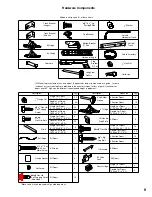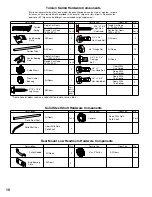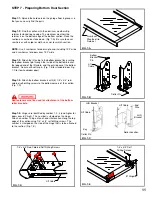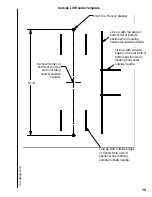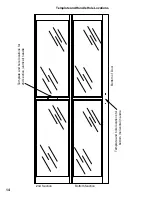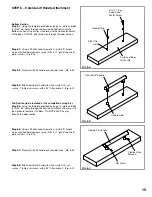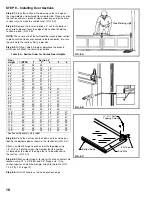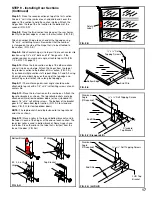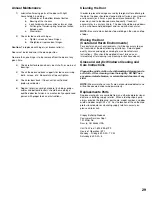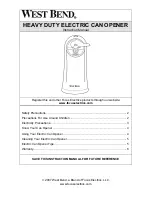
23
Lock the door in the down position securely using door lock
or locking pliers. This must be done to prevent the door
from prematurely opening which could cause an injury.
NOTE:
You need an assistant in Step 15-6. If your garage has
only one entrance, be sure you, the assistant, and the tools you
need are inside before you lock the door. Your door will have
either one or two torsion springs. Each torsion spring consists of
spring coils, stationary cone, and a winding cone (FIG. 15-D).
The spring coils are color coded depending on the spring size
and the
winding cone
is color coded separately, either
red
or
black.
The color on the winding cone is to help identify on which
side of the door the spring is to be used.
NOTE:
Black winding cone torsion springs are used on the right
side of the door and red winding cone torsion springs are used
on the left side of the door when viewing the door from the inside
looking out. Failure to install the torsion springs on the correct
side will cause your door to function improperly and could result
in serious injury.
Step 15-5:
If door has low headroom front mount setup skip to
Step 19-1. Slip the torsion springs onto the spring tube, the
red
winding cone on the
left
end, the steel center bearing, center
bearing plate, and the
black
winding cone torsion spring on the
right
end (FIG. 15-E). Cable drums go on next, the
red
drum on
the left, and
black
drum on the right. The set screws on the
drums face the springs.
Spring anchor bracket secures the springs to the wall. You
must fasten securely with red-colored fasteners. Never
remove spring anchor bracket when springs are wound.
Step 15-6:
With an assistant, lift the complete torsion spring tube
assembly and slide the ends of the tube into the bearing on the
end bearing plates. With the tube level, mount the center bearing
plate to the center anchor pad using (2) 5/16" x 1-5/8" red-
headed lag screws. Drill 3/16” pilot hole for each lag screw.
Important:
These pilot holes must be no closer than 1-1/2" from
the sides and ends of the wood anchor pad.
Step 15-7:
Connect the spring(s) to the center bearing plate
using (2) 3/8” x 1” hex bolts and nuts for single springs or (2) 3/8”
x 1-5/8” hex bolts and nuts for double springs. (FIG. 15-F)
Step 15-8:
Bring up the left cable between the wall and roller
shafts to the cable drum. Attach cable by placing in the notch on
the cable drum. Turning the cable drum and sliding it up tight
against the end bearing plate to remove the cable slack.
Make
sure the cable follows the grooves in the cable drum.
The
set screws on the cable drum should be tightened with a 3/8"
box wrench while holding the cable taut. (
Caution:
Set screws
should be turned from ¾ to one full turn after they have made
contact with the tube.) Clamp locking pliers on to the torsion
spring tube to maintain tension on the cable. Repeat this
procedure on the opposite side.
FIG. 15-D
FIG. 15-E
FIG. 15-F
Winding Cone
Spring Coil
Stationary
Cone
Red Cable
Drum
Red Winding
Cone
Right Wound
Spring
Steel Center
Bearing
Center Bearing
Plate
Left
Wound
Spring
Black Winding Cone
Black
Cable
Drum
3/8” x1-5/8”
Hex Head Bolts
3/8” Hex
Nuts
Center Bearing Plate

